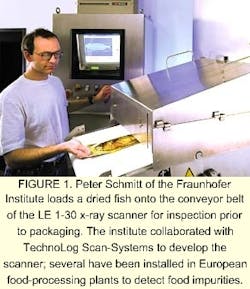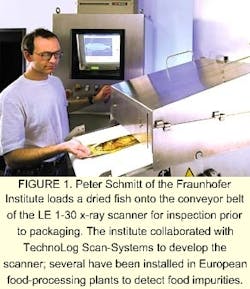X-ray scanner finds food impurities
Jointly developed vision system quickly interprets images of fast-moving food products for purity.
By Lawrence J. Curran,Contributing Editor
Leonard da Vinci once wrote that "man . . . is merely a passage and channel for food . . . ," but if foreign particles or other impurities find their way into that channel, dire physical and legal consequences can result. An x-ray scanner developed by two German firms is designed to assure that no unwanted particles get into packaged or bulk food products prior to sale.
The Fraunhofer Institute for Integrated Circuits IIS-A (Erlangen, Germany) developed and built the CCD-based time-delay integration (TDI) x-ray camera, as well as the image-processing software that TechnoLog Scan-Systems GmbH (Elz, Germany) integrated into the LE 1-30 x-ray scanner (see Fig. 1). The PC-based software quickly and automatically interprets captured x-ray images as products move along above the camera on a conveyor. If the system detects flaws in a food item, it sends a command to a downstream machine to reject that item. Images of rejected items can be stored and later analyzed, providing a valuable quality-control tool.
Several systems have been installed in food-processing and packaging facilities in Europe. One system has been used in food production for more than two years, yielding results that have prompted the customer to purchase two more, says Eric Runkel, TechnoLog's owner and president.
Peter Schmitt, head of the Sensor Technology Group of the Development Center for X-ray Technology at the Fraunhofer Institute, says his organization and TechnoLog Scan-Systems were once competitors. The two organizations decided to join forces for certain jobs a few years ago after realizing that the strengths of each firm make a formidable combination. "We knew that in this kind of application, TechnoLog had considerable mechanical expertise, and our strength is in the software and the x-ray camera," Schmitt says. Those two elements are Fraunhofer's contribution to the LE 1-30; TechnoLog's specialty is x-ray scanner systems.
System ingredients
According to Schmitt, most high-power x-ray sources can be used in the scanner. In addition to the Fraunhofer-developed camera and the institute's Power Process image-processing software, other key elements in the system include a 400-MHz dual Pentium III-based PC running Windows NT and a commercial frame grabber. The PC supplier varies from system to system, Schmitt says.
Other subsystems associated with the x-ray source are high-voltage controls, a high-voltage generator, a closed-water-cycle-tube cooling system, and a shielding cabinet (see Fig. 2). All of these are assembled by TechnoLog, which also installs the x-ray source. Runkel says the source can be purchased from several suppliers.
Schmitt points out that conventional linescan x-ray cameras used in food inspection have pixels that are "large at 0.8 mm." The resolution isn't fine enough to search for a small glass splinter, nor is the signal-to-noise ratio sufficient to provide enough contrast to detect flaws in the food being inspected. "We decided that we needed a resolution of 0.25 mm for food inspection," Schmitt says, which is the pixel size used in the direction perpendicular to the scan direction. "But photodiode linescan cameras don't provide a sufficient signal-to-noise ratio. The image is noisy, making it difficult to see flaws."
To overcome these limitations, Fraunhofer chose to build a CCD-based TDI camera. It delivers 1024 pixels/line and 256 lines that are perpendicular to the direction of food flow. The sensor is 6.6 mm wide; as food passes it and is exposed to x-rays, there's more time to integrate the images than there is with a conventional linescan camera. This results in an improved signal-to-noise ratio in the images produced by the TDI camera, according to Schmitt.
With the Power Process software a user can change the filtering algorithm without leaving the inspection program. "Normally there's a list of possible filtering algorithms, and if none fits the task, the system must be stopped and reprogrammed. Our system allows an operator to change the software, adding a new filter quickly when the product being inspected changes. If the system is using filter A, for example, the operator can see what happens in the images and set limits interactively, knowing which [image] shows a defect and which does not," Schmitt adds. "We developed the filtering algorithms based on our experience with x-ray imaging."
The operator only has to know how to use a PC and select a product category, such as filled jelly jars or pizza to be packaged. The PC then applies the proper set of algorithms for that product, which have been preprogrammed into the vision system.
Schmitt points out that the x-ray scanner enhances quality control because, for example, "sometimes the topping slips off an oven-ready pizza, and there may be six slices of salami instead of the allotted seven (see Fig. 3). This system can detect such discrepancies in the amount or distribution of product ingredients, as well as any foreign bodies, with a resolution as precise as one-quarter millimeter."
How it works
TechnoLog's Runkel describes the system as essentially a tunnel, which provides shielding from the x-ray elements inside. A collimator—a small slot in a slab of lead—focuses the x-rays into a curtain-like form to illuminate the food product moving on the conveyor belt. The food items absorb some of the radiation while the x-ray camera below captures those that pass through one line at a time, Runkel says. The use of a TDI camera allows the PC to add the results of the first scan to the second, the second to the third, and so on, until a shadow image of the product is created. The image is "much brighter than those produced by a conventional linescan camera because of the TDI camera's low noise level," Runkel points out.
FIGURE 3. This pizza was inspected before being packaged. Occasionally a slice of salami or pepperoni is missing. In this instance, it's questionable whether a slice is missing at (about the 8 o'clock position), so the pizza would probably be rejected.
"The camera produces an image using as many as 256 exposures from one spot, with the speed depending on the resolution required and the forward speed of the conveyor," he adds. TechnoLog wrote the specs for what the image-processing software should provide "because we've seen problems with x-ray scanners, especially if the algorithms aren't tailored to food processing," Runkel says.
All products, whether bulk fruit or jars of jelly, are passed to the x-ray scanner by the machine ahead of it in the production line. The PC activates the scanner, processes the images, makes a decision to pass or fail the product being inspected, then sends a signal via an RS-232 link to the mechanism used in a given inspection line as the rejection tool. This could be a pusher arm that redirects a package or an air jet from a nozzle that can be controlled to reject only the one stone that somehow made its way into a flow of bulk nuts being inspected.
"There's a lot of signal exchange between machines ahead of a scanner and those that follow it in this kind of line," Runkel points out. For example, the LE 1-30 can send a signal to a previous machine to lower its temperature, if its function is to heat the food product, or to fill containers to a higher level, if the x-ray scanner detects a shortage in an inspected jelly jar, for example.
According to Runkel, the most important nonimaging-related challenges TechnoLog faced in developing the LE 1-30 x-ray scanner included the need for a simple graphical user interface (GUI), flexibility in adding new algorithms to inspect new products, and versatility in accommodating a variety and mix of food products. The GUI has to be "simple and reasonable enough for a worker" on such an inspection machine to master with only a short training period, Runkel says. "We chose a Windows-based program and integrated it into our control buttons so that it is easy to use."
COMPANY INFORMATIONFraunhofer Institute for Integrated Circuits IIS-A91058 Erlangen, GermanyWeb: www.fhg.deTechnoLog Scan-Systems GmbH
65604 Elz, Germany
Web: www.technolog.de

